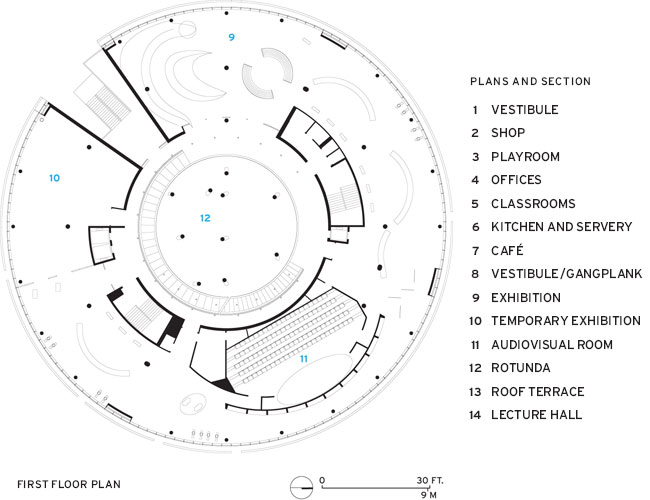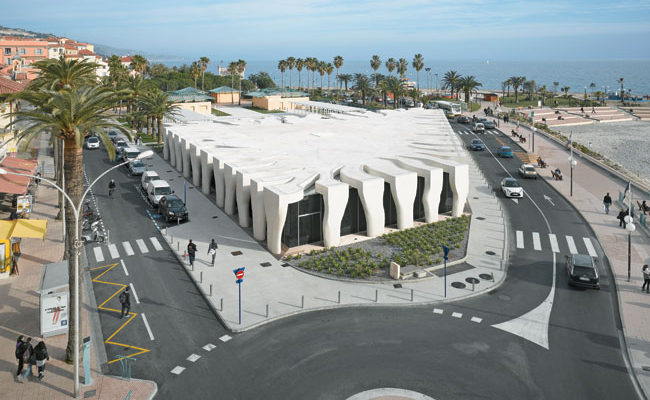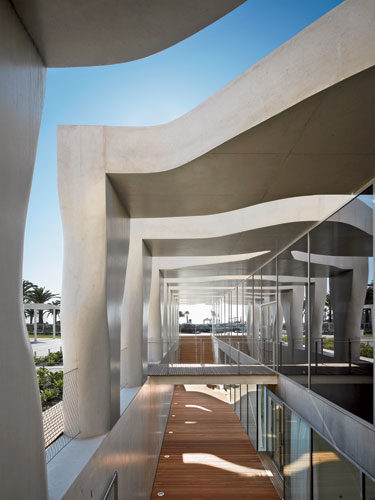Menton, France
If there is any corner of the world less in need of a new architectural icon, it's Menton, a lovely seaside hill town situated 2.5 miles from Italy on the French Riviera. With its gardens, villas, and picturesque historic center, Menton retains the charms that once attracted luminaries such as Aubrey Beardsley, William Butler Yeats, and the French poet, artist, and filmmaker Jean Cocteau (1889–1963). But when municipal officials began to court the American art collector Séverin Wunderman, and offered to build a permanent home for his collection of 990 works by the Surrealist Cocteau, the wheels were set in motion to create a building that, in the words of Deputy Mayor Jean-Claude Guibal, would give Menton “the status of a cultural destination in its own right, where bold projects ennoble the spirit of the site and reinforce its authenticity.”
One of the keys to Menton's character is the urban and contextual quality of its architecture. Old resort hotels stand back from the beach behind handsome gardens, directly lining a lively city street behind them. The hill town, with its Baroque church and tower, forms a solid compositional mass in the landscape, and the surrounding villas and terraced gardens are intimately engaged with the precipitous terrain.
The Cocteau Museum, on the other hand, is isolated by surrounding streets and an overscaled entry plaza. It stands as an insular block with a uniform exterior skin on all sides that takes no cues from its urban context; it could be anywhere. The spaces created by its projecting columns are too shallow to produce the shady pergolas for pedestrians that the photographs promise. Even the deep porch over the entry facade disappoints, as the ground falls away under it to give access and daylight to basement-level offices, a classroom, and a document center, instead of offering a cool place to linger—visitors are forced to approach the building over narrow entry bridges.
The museum stands on a point jutting into the water, and its triangular form effectively frames the curving bay of the beach. From here, the rhythms of its columns offer a contemporary interpretation of the arches below the promenade that overlooks the old fishing port. Yet while the promenade follows the cascading topography, making it accessible from above and below, Ricciotti's building offers no such multilevel interplay.
Inside, the museum is a free-plan space, like a floor in a speculative office building. It is enclosed entirely by tinted floor-to-ceiling glass, a dubious solution for exhibiting Cocteau's delicate drawings and projections of his films. The glare dims the projections, and curators have rigged shading curtains in some areas. A central core separates the entrance—housing a café, bookshop, and temporary exhibition space—from the permanent exhibits. The finishes are uniformly white.
The project's payoff is the energized columns and roof cuts, which frame handsome views from inside. Thrillingly, they seem to challenge the structural integrity of the building, especially at the corners. The formal articulation of the cuts is clumsy, however. Each column has a seemingly unique shape, with undulating curved forms and rounded edges. At their heads, they widen awkwardly into squared-off profiles to meet the projecting fingers of the roof slab, creating prominent knuckles. Conceptually, there are two structures here, a concrete spider that crouches over a glass pavilion, but this is poorly articulated.
Discussing his project, Ricciotti rejects the “terrorist cultural practices of Minimalism” and “the doubtful imperialism of an academic modernism,” declaring instead his admiration for “the arrogance of Mr. Cocteau.” But one's overall impression of his building is that a single slick gesture stands in for a general lack of focus, rigor, and ambition, and that the design defrauds the expectations it raises.
Based in Madrid, David Cohn is an international correspondent for RECORD.
Beyond the Surface
 |
| PHOTOGRAPHY: © Lisa Ricciotti |
| The horizontal cuts in the roof, as deep as 23 feet, required heavy reinforcing. They were made with laser-cut polyester molds. The columns were cast using a total of nine different resin-backed steel molds. |
The architects devised nine different column shapes for the building’s perimeter, and they flipped these horizontally and vertically to simplify the design and fabrication processes. But, according to structural engineer Eric Vallauri, creating these compound curves was a challenge. The crew built full-size wood mock-ups of the unique columns. Then they used the models to produce steel molds and lined them with resin for an extra-smooth finish, bolstering them from behind with wood props. Although the concrete is not high strength, the mix includes white cement combined with half the amount of gravel typically used for more standard concrete. The reason: to achieve a smooth, brilliant finish. One of the consequences, however, is extensive surface cracking on columns facing the sea and southern sun—a common problem in work of this kind. Apparently, overheating during the setting process caused a rapid loss of moisture, resulting in the cracks, which stood out clearly during a recent visit, as they have become stained with rust from the rebars. The cracking might have been avoided, Vallauri suggests, if more expensive marble gravel had been used instead of cutting back on the quantity of gravel.
Vallauri says that the structural design and calculation of each column took three weeks, “when the normal time is ten minutes.” This, he explains, was due to their unusual shapes, and in response to moderate seismic loads. Additionally, slices cut deep into the edges around the 16-inch-thick roof slab required heavy reinforcing. Formed with laser-cut polyester molds, these amorphous notches are edged by 12-inch-deep-by-2-inch-high grooves that accommodate skylightlike glazing.
Ricciotti emphasizes that “concrete allows one to create projects that are not necessarily complex in technical terms, but rather in terms of their craftsmanship.” Despite the effort expended on crafting the concrete, the work is compromised by the extensive cracking, awkward detailing, and gaffs like a seismic joint in the roof slab located directly over a main entry. Such carelessness is surprising, and is perhaps another sign of how tired and lazy the recourse to the one-off architectural icon has become. D.C.
PeopleOwner: Ville de Menton Architect: Personnel in architect's firm who should receive special credit: Engineer(s): SUDECO INGENIERIE Consultant(s): Lighting: LIGHTEC Acoustical: THERMIBEL Gross square footage: 23,235 square feet Total Project Cost: $13.4 million Completion date: November 2011 |
ProductsStructural System: Exterior Cladding: Interior surfaces: RPM Bally (wallcovering, paint, flooring) Elevators: Kone |








